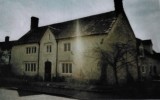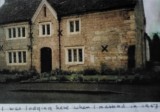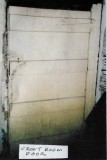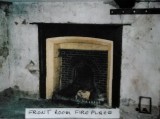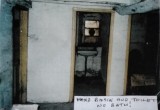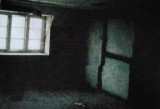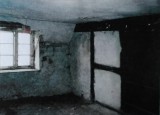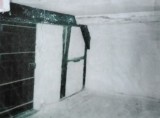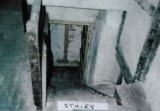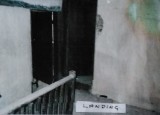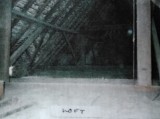Have you ever wondered about the empty house which stands next to The Spar in Badsey High Street? It has been empty for a good 30-40 years, but older members of the village will remember it as the home of the Cull family who had the Sumachs Bakery at the rear. What is its history?
* * * * *
A 17th-century house
No 18 High Street is a Grade II listed building on the National Heritage List for England. It was listed on 30th July 1959 and was described as follows:
House 17th century, remodelled 1867. Coursed rubble with ashlar quoins, partly rebuilt in brick and faced in roughcast. Tile roof; gable-end stacks. Two storeys; three windows, central one under a gablet, of four lights to left and two lights, all stone mullioned. Ground floor a 4-light stone mullioned window to left, 3-light to right, both with square labels. Central entrance has a C19 ledged and boarded door. Datestone in left-hand-gable.
Ownership by the Simpson Family
In 1812, at the time of the Badsey Enclosure Act, this house was an old enclosure which belonged to Joseph Simpson. It was a house and homestead and amounted to nearly 1½ acres, with land reaching down to Badsey Brook. There had been Simpsons living in Badsey since the 17th century, but whether they had lived in the same house since then is not known. From at least the mid 18th century until the middle of the 19th century, a family-run baker’s business had operated from the premises. Joseph’s grandfather, John Simpson (1731-1797), and his father, William Simpson (1759-1807) were both bakers, and Joseph, the eldest son, carried on in the family business. He was 17 when his father died. By the terms of his father’s will, Joseph was to inherit the house and land after his mother’s death or remarriage: “all that my freehold messuage, tenement and premises wherein I now live with the garden, yard, barn and orchard”. Hannah, William’s widow, did not die until 1836 but, in 1813, she remarried, to Anthony Smith, and so Joseph Simpson was listed as the landowner at the time of Enclosure.
Joseph never married. In 1841 he was living alone in the family home, still carrying on the bakery business. However, he must have been in financial difficulties as, by It is likely that he lived in the Chapel Street area of Badsey, in the vicinity of Rose Cottage and Vine Cottage. He was still living there in 1851, he was working but as a labourer and lodging across the road at The Alley. He appears to have sold the property at some time during the 1840s to siblings Sarah, Mary and William Byrd, who lived nearby at The Poplars and owned the land to the south. By the terms of his father’s will, Joseph had had to pay sums of money to his siblings when he inherited the house, and so this had probably resulted in having to mortgage the property and then ultimately sell it. He died at Evesham Union in 1868, aged 78.
Ownership by the Byrd Family
The Byrds were major landowners in Badsey and Aldington so never lived in the property and let it out to tenants. In 1851, it appears that the house was occupied by Harry and Elizabeth Bennett and family. A few years later the house was refurbished, as a date of 1857 (or possibly 1867, as the third digit is unclear) can be still be seen on the south wall. It may have been then that a building was added at the back which was later used as a bakery, as an additional building can be seen on the 1883 Ordnance Survey map.
For a few years, the house was used as a shop. The 1861 census records William Harris, a beer-seller and shopkeeper living there with his family.
By 1871, however, it was a residence for farmer Joseph Smith, his wife, Sarah, and their daughter Emma and her husband, Adolphus Wright. The house was uninhabited in 1881. By this time, Sarah Byrd, the last of the Byrd siblings had died. It had been inherited by their nephew, Thomas Byrd. He retained the land to the north, upon which a dwelling-house (the present-day Spar) had been built in the late 1840s, but sold the house to a baker and confectioner, John Ernest Cull, in the early 1880s.
Ownership by the Cull Family
Some time in the early 1880s, newly-married John Cull bought this house on the High Street from Thomas Byrd. John had been born at Bengeworth in 1860, the son of Bazaleel Cull, a Port Street baker and confectioner. He had married Ruth Sylvester, the Badsey National School Mistress, in 1881. They were living in Badsey by January 1884 when their first child, Walter John, was born. Between then and 1900, nine more children were born (three more sons and six daughters).
John quickly set about establishing his baker’s business. John, Ruth and their children lived in the main house whilst the bakehouse was in the extension at the back.
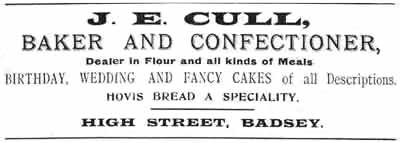
Throughout most of the 20th century, it was known as The Sumachs Bakery after a Japanese tree. John Cull’s four sons all began their working careers assisting in the business. But John Sidney Cull, the third son, died of influenza in Mesopotamia just a few weeks before the end of the First World War, and Walter, the eldest son, had turned to market gardening by 1921.
Ted Wheatley, in his Memoirs of Badsey Life, 1920s-1980s, described the Cull family thus:
Badsey had two bakers. One was Mr Cull; his house and bakery was next-door to Lucy Ryman’s (now Meadows) shop; we bought our bread form him as it had to be the best bread in the district and his dough cakes were the real thing. Even now I can taste those dough cakes, we used to be standing waiting for them to be taken from the oven as they were best eaten hot; very indigestible I expect but well worth the discomfort. Old Granny Cull was a grand old lady who was always dressed in a man’s flat cloth cap, but the poor woman had a disfigured face caused by being kicked in her head by a horse. Their deliveries were made by the same method as everybody in those days, horse and cart, and when Mr Cull retired from the business, his sons took over, Basil [Alfred] and Edgar. Edgar was the one who made the deliveries but I’m afraid his sense of timing was not very good. We lived next door to the bakery [at The Poplars, demolished 1966] and should have had our bread in the afternoon but it was usually about 9.30 in the evening he finally reached us. I guess he looked forward to some of whatever was on the stove as he usually had supper with us and a good old natter; it was bed-time when he went off home.
I nearly forgot to say about Mr Cull’s sense of dress; he was always very smartly turned out and would rarely be seen outside without his bowler and highly polished boots and leggings. In later years, Edgar could be seen dressed very similarly to his Dad.
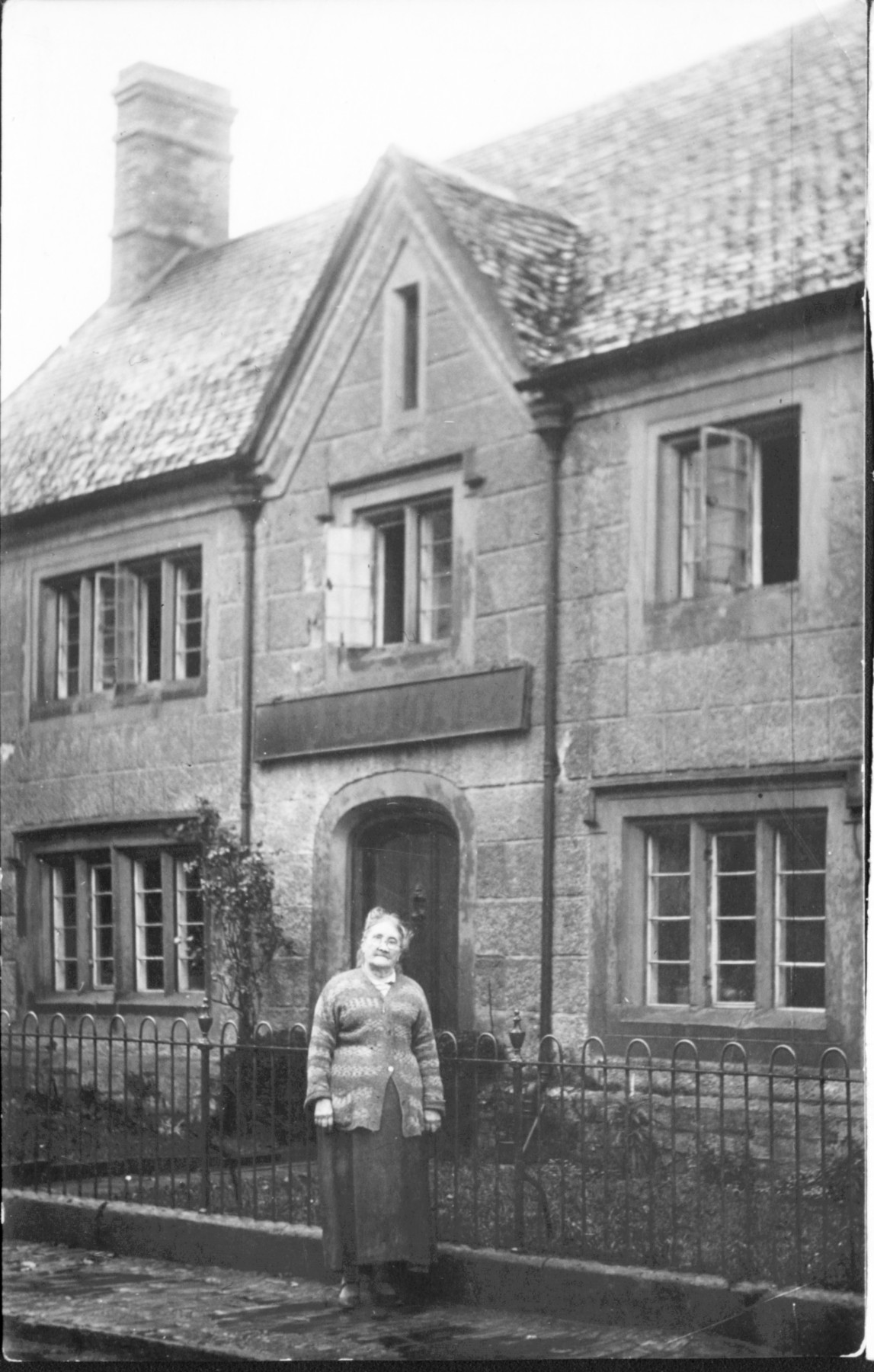 John Cull died in March 1929. After John’s death, Ruth carried on the bakery business with her other two sons, Alfred and Edgar. Ruth is pictured right outside The Sumachs, the photo taken some time in the 1930s (photo courtesy of Celia and Shirley Harrison, the granddaughters of Ruth Cull). The board across the door (probably a signboard for the bakery) is no longer there and the railings would have been removed during the Second World War for scrap iron. According to Ted Wheatley, there was a petrol pump outside the house which the Culls used for the bakery business.
John Cull died in March 1929. After John’s death, Ruth carried on the bakery business with her other two sons, Alfred and Edgar. Ruth is pictured right outside The Sumachs, the photo taken some time in the 1930s (photo courtesy of Celia and Shirley Harrison, the granddaughters of Ruth Cull). The board across the door (probably a signboard for the bakery) is no longer there and the railings would have been removed during the Second World War for scrap iron. According to Ted Wheatley, there was a petrol pump outside the house which the Culls used for the bakery business.
Ruth died in April 1938, so it was left to her surviving sons to carry on as best they could. Alfred, who had married Lucy Ellen Smith in 1931, lived in the family home at The Bakery on the High Street, whilst Edgar, who had married Ethel Banner in 1922, lived at Stanley House, Bretforton Road, along with their daughter, Hope.
During the 1940s, the house was the scene of two wedding receptions. In September 1942, Alfred’s niece, Hilary Margaret Sylvester Drew (the daughter of his sister, Lilian Ruth), married Adrian Roy Allen at Bretforton. Afterwards, according to a report in The Evesham Standard, “the reception was held at the house of Mr & Mrs A E Cull, The Shumacks (sic), Badsey”. In March 1948, Adrian Allen’s sister, Audrey Doreen, also had her wedding reception at The Sumachs.
During the 1950s and 1960s, Alfred and Lucy’s home, now known as 18 High Street, was used as a lodging house. One lodger was Roy Page, who describes his memories of living with the Culls in section 4 of A Badsey man from London - Roy Page's memories of living in Badsey from 1948. Roy lodged there from October 1951 (after being demobbed from The Royal Army Ordnance Corps) until his marriage to Mary Cook in March 1953.
When I came home I went into lodgings with Bass [Alfred] and Lucy Cull's house, “The Sumachs”, in the High Street, a stone house to the left of the shop. At the back of the house was a bakery where they baked cakes and pies. Bread was made by Lawrance’s in a bakery opposite 23 Brewers Lane.
Bass and Aunt Lucy, as she was known, were a nice couple if rather odd! Lucy loved cats and had as many as a dozen in the house. This was OK except for the fact that she insisted on feeding them on the end of the same table (a large one I admit) as us. I have to say that looking at a row of cats’ bottoms while you are eating is not nice and not only that but you would occasionally find a long tabby, black or grey hair in your meat pie or cake!
Bass Cull had a club foot and a withered hand but still managed to drive an old van around the local villages delivering bread and cakes. The trouble with Bass was he had strong political views – he was a fascist (Blackshirt) like one or two others in the village and was very often still delivering at 10 o’clock at night. This was said to be one of the reasons why the business failed along with the fact that Lucy was too soft-hearted to demand money from people who owed them.
By some time in the 1950s, poor health obliged the Cull brothers to give up the bakery. Alfred had been an invalid for a great part of his life, and Edgar had been severely wounded in the head whilst serving in the First World War – an experience which had a lasting effect on him. Alfred died at 18 High Street in 1961. His widow, Lucy, remained living there until her own death in 1986.
The land behind the bakery was sold off in the 1960s for housing development on Seward Road. The former bakery was converted into residential accommodation (No 18A High Street) - see photos below taken by Peter Stewart in 2008.
At some stage, probably after the death of her husband in 1972, Hilda Annie Aldrich (née Cull), moved from Sedgeberrow to live in the converted accommodation, 18A. She was certainly living there by August 1977, as the Parish Review of that month listed all the people who received the Sacrament at home, which included Hilda and her sister-in-law, Lucy Cull. Hilda died at No 18A in 1983.
It may have been then that Hilda’s only son, George Alfred Aldrich, came to live in Badsey. He had been a chemist, like his father, but had retired early. As Alfred and Lucy Cull had no children, it is assumed that George inherited both Nos 18 and 18A. George took up residence at No 18A which remained his home for the rest of his life until his death in October 2024. But No 18 remained empty after Lucy’s death in 1986.
The future
What was once a bustling family home fronting on to the High Street has lain empty for many years – its future unknown. It has been in the same family for almost 150 years but, with the death of George Aldrich – the last of the Cull family to live in the area – no one knows what will happen to it.
The late Roy Page, who died in May 2024 and who lodged in the house in the 1950s, was permitted to see inside the house in 2004. The photos below give some idea of the interior. In 2008, Roy's son, Tim, worked on emergency repairs on the house to stabilise the front wall to prevent it from collapse. The five tie-bars were inserted and the rendering was removed in order for cracks to be repaired.
Let's hope that at some time in the future it will once more become a family home.
Maureen Spinks, January 2025.
Acknowledgements
With thanks to Brian Smith for providing copies of the photographs taken by Roy Page.

